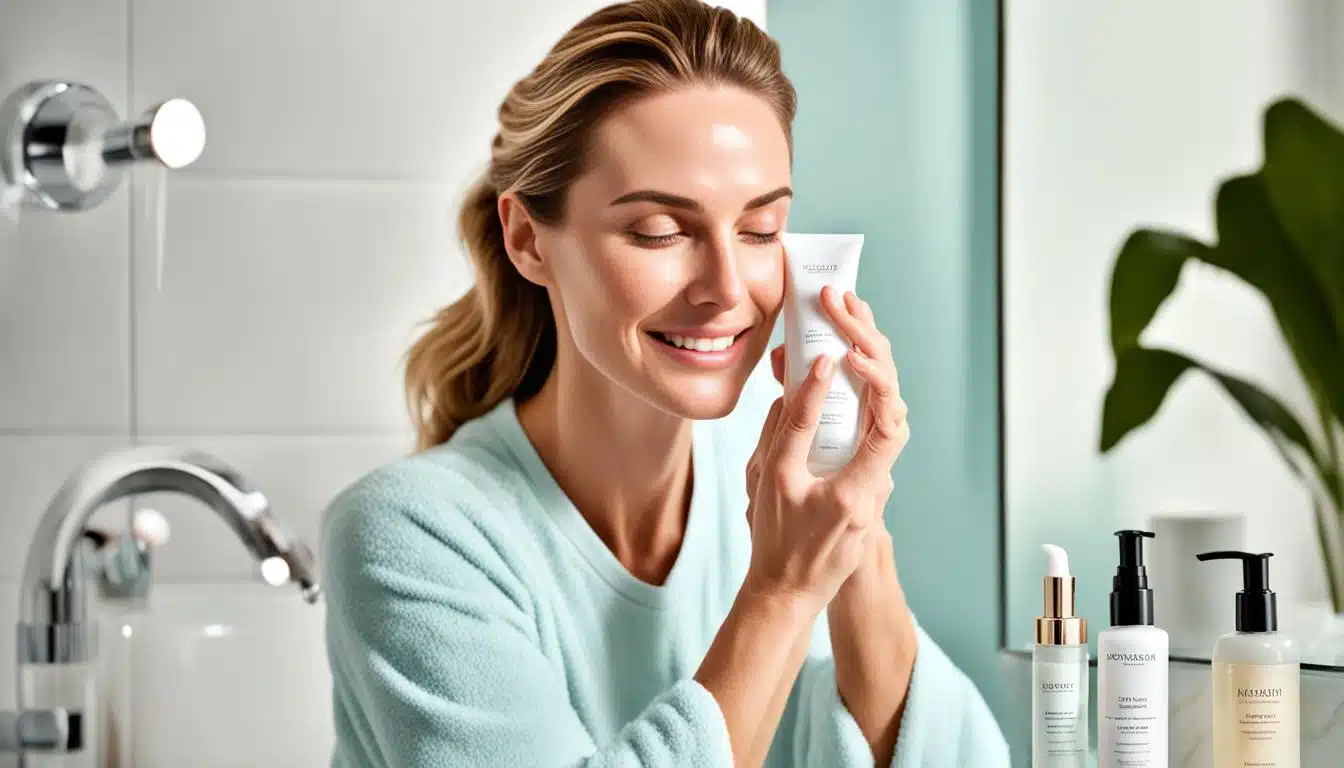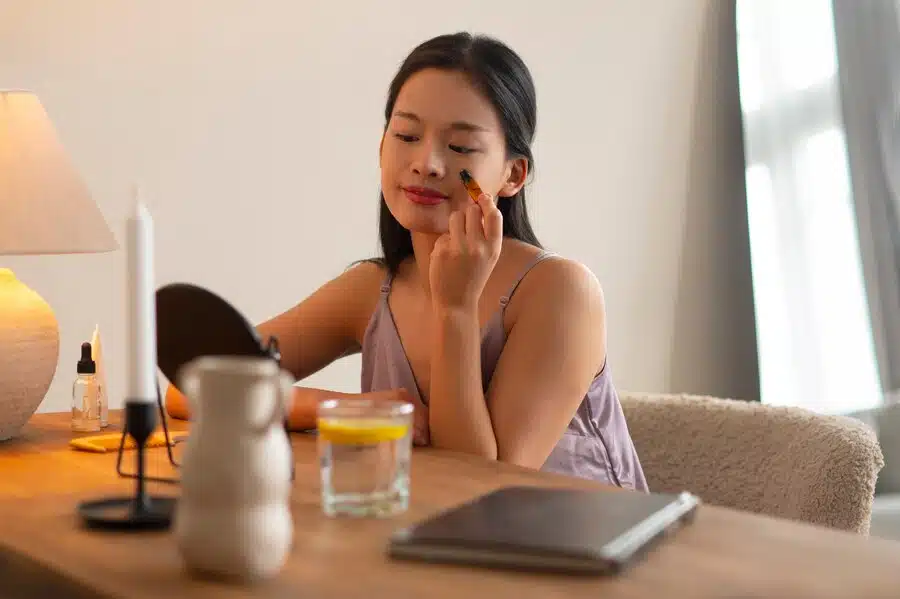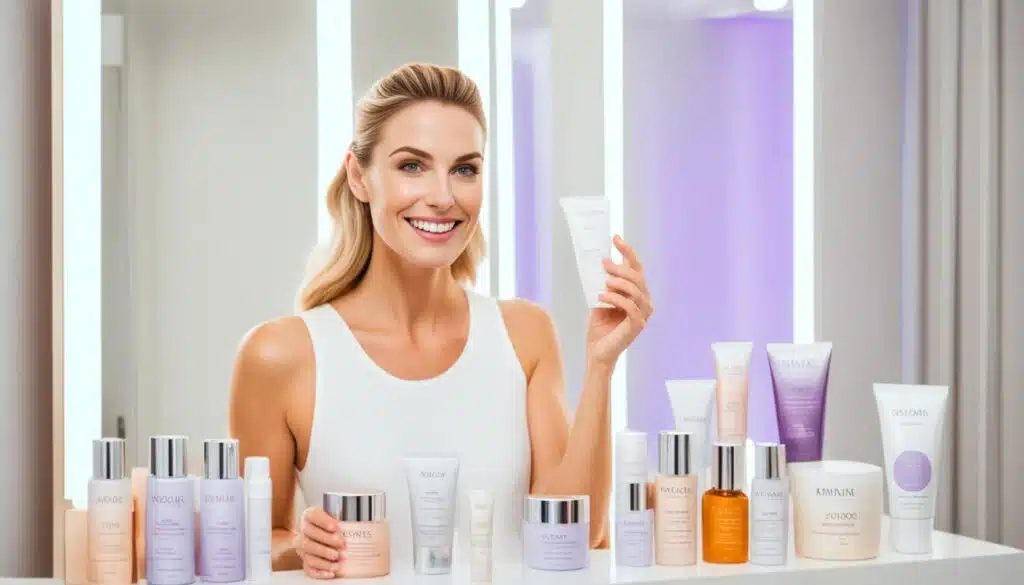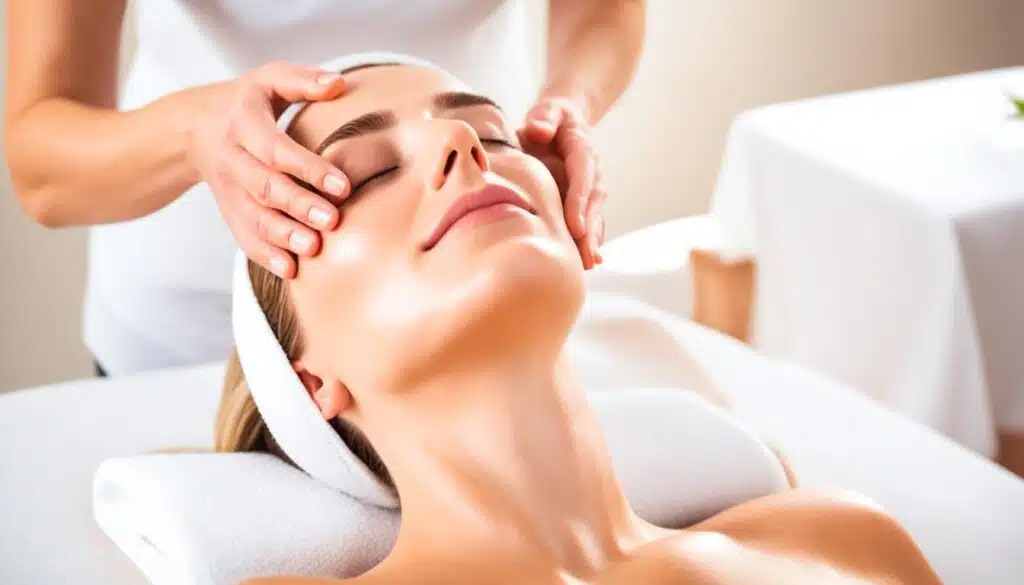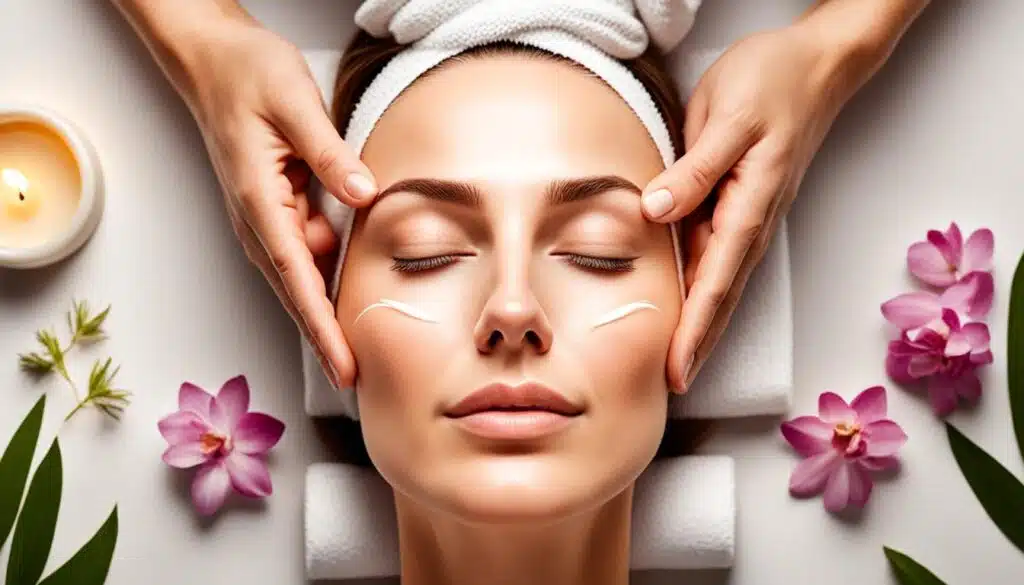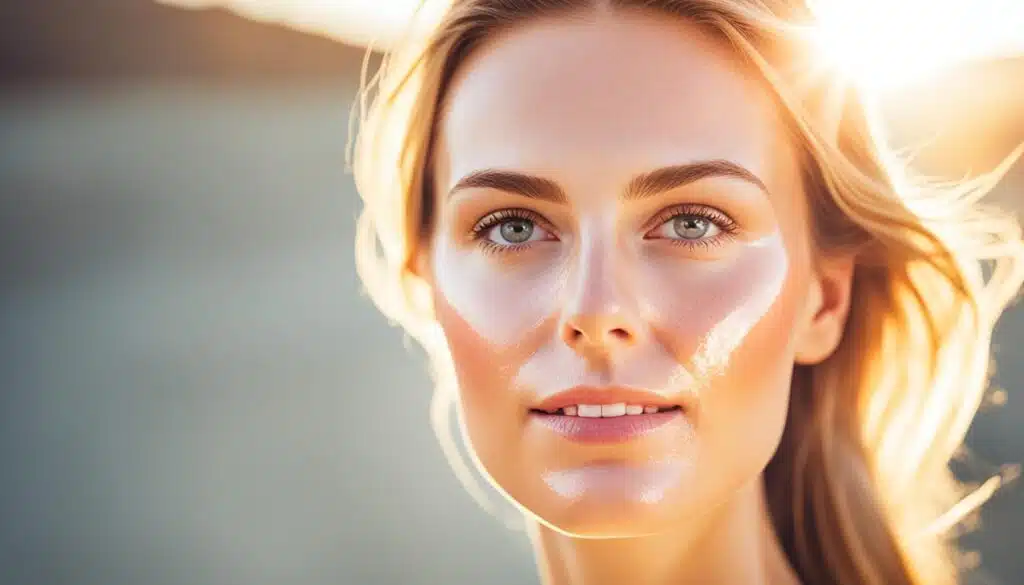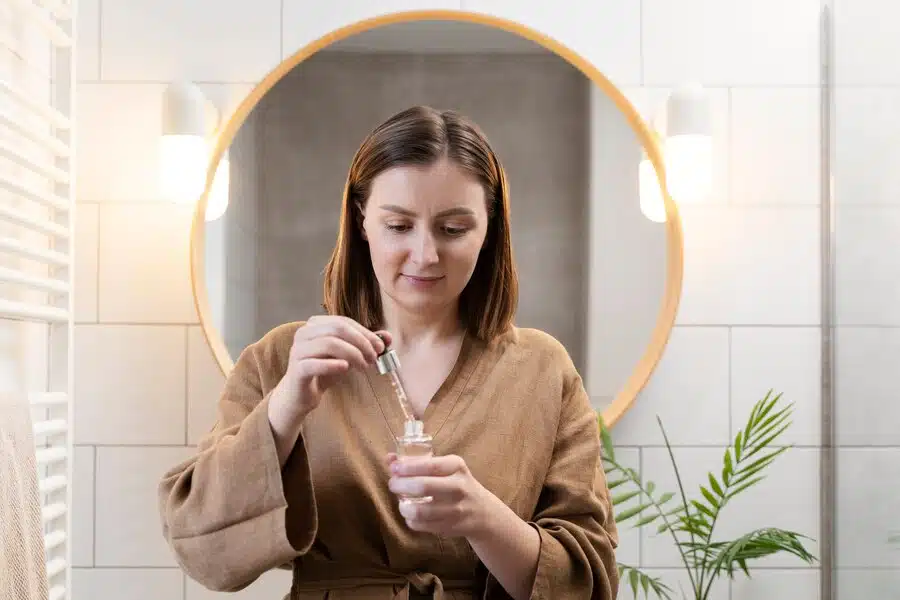Skincare Routine For Glowing Skin Are you longing for radiant, glowing skin? A skincare routine tailored to your needs can make all the difference. By following a consistent regimen, you can revitalize your look and achieve a complexion that exudes radiance.
Key Takeaways: Skincare Routine For Glowing Skin
- A well-rounded skincare routine is crucial for achieving and maintaining glowing skin.
- Consistency is key to achieving the best results.
- Protect your skin from harmful UV rays by incorporating sun protection measures into your routine.
- Choosing skincare products that are appropriate for your skin type and concerns is essential.
- Don’t forget the power of facial massage and the benefits it offers for glowing, tighter skin.
The Basics of a Skincare Routine
A skincare routine is essential for maintaining healthy and glowing skin. It involves a series of steps to care for your skin and should be followed consistently to achieve the best results. Whether you’re a skincare enthusiast or just starting out, understanding the basics of a skincare routine is the first step towards achieving a radiant complexion.
So, what does a good skincare routine entail?
Morning Skincare Routine
Starting your day with a morning skincare routine is crucial to prepare your skin for the day ahead. The morning routine focuses on cleansing, protection, and nourishment.
- Cleanse: Begin by cleansing your skin with a gentle cleanser to remove any impurities or excess oil.
- Protect: Apply a broad-spectrum sunscreen to protect your skin from harmful UV rays. Look for a sunscreen with an SPF of 30 or higher.
- Nourish: Follow up with a lightweight moisturizer to hydrate and nourish your skin.
An effective morning skincare routine not only helps you start the day with a fresh face but also protects your skin from environmental stressors.
Nighttime Skincare Routine
Your nighttime skincare routine focuses on repairing and rejuvenating your skin while you sleep. It involves removing makeup, deeply cleansing the skin, and providing it with the necessary hydration.
- Remove Makeup: Start by removing makeup and dirt from your face using a gentle makeup remover or micellar water.
- Cleanse: Cleanse your face with a facial cleanser suitable for your skin type to remove any remaining impurities.
- Treat: If you have any specific skin concerns, such as acne or fine lines, apply targeted skincare products or treatments.
- Moisturize: Finish your nighttime routine by applying a nourishing night cream or moisturizer to hydrate and repair your skin as you sleep.
A consistent nighttime skincare routine helps your skin recover from daily stressors and promotes a healthy complexion.
Remember, every individual’s skin is unique, and it’s essential to choose skincare products that suit your specific skin type and concerns. Additionally, consistency is key when it comes to skincare routines. Stick to your morning and nighttime routines religiously to achieve the best results for your skin.
Having a good skincare routine is the foundation for glowing and healthy skin. Stay consistent, be patient, and let your skin reap the benefits of a well-crafted skincare regimen.
Morning Skincare Routine
Starting your day with a proper skincare routine is essential for maintaining healthy and glowing skin. By following a morning skincare routine, you can protect your skin, cleanse away impurities, and moisturize to keep your skin nourished throughout the day.
Cleansing
Begin your morning skincare routine by gently cleansing your skin. Use a gentle cleanser that suits your skin type to remove any dirt, oil, or sweat that may have accumulated overnight. Cleansing helps to unclog pores and prepares your skin for the subsequent skincare products.
Skincare Products
After cleansing, it’s time to apply skincare products that will address your specific skin concerns. This may include serums, moisturizers, and any other products that are a part of your daily skincare regimen. Look for products that are suitable for your skin type and target your unique needs.
Moisturize and Protect
Moisturizing is a crucial step in your morning skincare routine. It helps to replenish moisture, keep your skin hydrated, and maintain its natural barrier function. Choose a moisturizer that suits your skin type and has SPF protection to safeguard your skin from harmful UV rays.
One of the most important steps in your morning skincare routine is protecting your skin from the sun. Apply a broad-spectrum sunscreen with an SPF of 30 or higher to shield your skin from harmful UV rays. Remember to reapply sunscreen throughout the day, especially if you’ll be spending time outdoors.
Healthy Habits
In addition to your skincare routine, maintaining healthy habits can contribute to overall skin health. Stay hydrated by drinking plenty of water, eat a balanced diet rich in skin-friendly foods like fruits, vegetables, and healthy fats, and get enough sleep to allow your skin to repair and regenerate.
By following a consistent morning skincare routine and adopting healthy habits, you can protect your skin, cleanse away impurities, and moisturize it to achieve a radiant and glowing complexion.
Choosing the Right Skincare Products
When it comes to skincare, selecting the right products can make all the difference. With so many options available, it’s important to consider your skin type and specific concerns. Whether you have dry, oily, sensitive, or combination skin, finding products that are gentle and suited to your skin type is key.
Start by identifying your skin type. Is it dry and in need of hydration? Oily and prone to breakouts? Sensitive and easily irritated? Combination, with oily t-zones and dry cheeks? Understanding your skin type will help you choose products that address your specific needs.
Addressing Specific Skin Concerns
While considering your skin type is important, it’s also essential to address any specific skin concerns you may have. Whether you’re dealing with acne, dark spots, fine lines, or dullness, there are skincare products available to target and improve these issues.
Look for products that are formulated to address your specific concerns. For acne-prone skin, choose products with ingredients like salicylic acid or tea tree oil to help clear breakouts. If you’re concerned about hyperpigmentation, look for brightening serums and creams with ingredients like vitamin C or niacinamide. For fine lines and aging skin, opt for products with retinol or peptides to promote smoother, more youthful-looking skin.
Gentle Skincare Products
It’s important to choose skincare products that are gentle on your skin. Harsh ingredients and irritants can disrupt the skin’s barrier, leading to redness, dryness, and other negative effects. Look for products that are dermatologist-tested, fragrance-free, and free from potentially irritating ingredients like alcohol, sulfates, and parabens.
Reading product labels and researching the ingredients can help you identify gentle skincare options. Look for products that are suitable for sensitive skin, as these are generally formulated to be gentle and non-irritating.
Finding Products That Suit Your Skin Type
Once you’ve considered your skin type and concerns, it’s time to find products that are specifically suited to your unique needs. Look for labels that indicate the product is intended for your specific skin type, such as “for oily skin” or “for dry skin.” These products are formulated to address the specific needs of your skin type, providing the best possible results.
Additionally, seeking recommendations from trusted sources such as dermatologists or skincare professionals can help guide you in choosing the most suitable products for your skin.
Affordable and Effective Options
Skincare doesn’t have to break the bank. There are plenty of affordable options available that are just as effective as their high-end counterparts. Don’t be swayed by high price tags – instead, focus on the ingredients and formulation of the products.
Comparing different skincare products, reading reviews, and learning from others’ experiences can help you find budget-friendly options that deliver results. Remember, the price of a product doesn’t necessarily equate to its effectiveness or suitability for your skin type and concerns.
Skincare Products for Different Skin Types
| Product Type | Best for | Key Ingredients |
|---|---|---|
| Cleanser | All skin types | Gentle surfactants, hyaluronic acid |
| Moisturizer | Dry or combination skin | Hyaluronic acid, ceramides, shea butter |
| Gel or lightweight moisturizer | Oily or acne-prone skin | Salicylic acid, niacinamide, tea tree oil |
| Hydration serum | Dull or dehydrated skin | Hyaluronic acid, vitamin C |
| Sunscreen | All skin types | Broad-spectrum SPF, zinc oxide |
Remember that everyone’s skin is unique, and what works for one person may not work for another. It may take some trial and error to find the perfect skincare products for your skin type and concerns. Be patient and listen to your skin’s needs, adjusting your routine as necessary.
Sun Protection for Glowing Skin
Sun protection plays a crucial role in maintaining the health and radiance of your skin. Harmful UV rays from the sun can cause premature aging, skin damage, and even increase the risk of skin cancer. To protect your skin from these harmful effects, it is essential to incorporate effective sun protection measures into your skincare routine.
One of the key steps in sun protection is wearing a broad-spectrum sunscreen. Broad-spectrum sunscreens protect your skin from both UVA and UVB rays, providing comprehensive protection against sun damage. Look for a sunscreen with an SPF of 30 or higher, and make sure to apply it generously to all exposed areas of your skin.
“A broad-spectrum sunscreen protects your skin from both UVA and UVB rays, providing comprehensive protection against sun damage.”
In addition to wearing sunscreen, it is important to take other protective measures while out in the sun. Wearing a wide-brimmed hat can provide extra shade and protect your face and neck from direct sun exposure. Seek shade whenever possible, especially during the peak hours of sunlight when the UV rays are strongest.
Remember that sun protection is not only necessary on bright and sunny days. UV rays can penetrate through clouds and even on cooler days, causing damage to your skin. Therefore, it is important to make sun protection a habit every day, regardless of the weather.
By taking these simple yet effective sun protection measures, you can safeguard your skin from harmful UV rays, reduce the risk of sunburn and skin damage, and maintain that radiant glow you desire.
The Importance of Broad-Spectrum Sunscreen
Using a broad-spectrum sunscreen is vital because it provides protection against both UVA and UVB rays. UVA rays can penetrate deep into the skin, causing long-term damage and premature aging, while UVB rays are responsible for sunburn. By using a broad-spectrum sunscreen, you can ensure that your skin is shielded from both types of damaging rays.
| Key Benefits of Broad-Spectrum Sunscreen | Frequently Asked Questions |
|---|---|
|
|
Evening Skincare Routine
Establishing an evening skincare routine is crucial for maintaining healthy and glowing skin. As the day comes to an end, it’s important to remove impurities, dead skin cells, and promote cell turnover to rejuvenate your skin overnight. Here’s a step-by-step guide to help you achieve an effective evening skincare routine:
1. Double Cleansing
To ensure your skin is thoroughly cleansed and free from makeup, dirt, and pollutants, start with a double cleansing method. First, use an oil-based cleanser to dissolve and remove any oil-based impurities. Follow it up with a gentle foaming or cream cleanser to cleanse your skin deeper.
2. Exfoliation
Exfoliating your skin in the evening helps to remove dead skin cells and promote cell turnover. Choose a gentle exfoliator that suits your skin type and apply it in gentle, circular motions. Be careful not to over-exfoliate as it can cause irritation.
3. Treatment Serums
After exfoliation, apply any treatment serums or targeted skincare products that address your specific skin concerns. Whether it’s for brightening, hydration, or targeting fine lines and wrinkles, look for products that contain active ingredients to nourish and repair your skin.
4. Moisturization
One of the most important steps in any skincare routine is moisturizing. Apply a suitable moisturizer to replenish and hydrate your skin after cleansing and applying treatment serums. Choose a product that suits your skin type to ensure optimal hydration.
5. Retinol Products
If you’re looking to target signs of aging and improve your skin’s texture, incorporating retinol into your evening skincare routine can be highly beneficial. Retinol helps to stimulate collagen production and promote cell turnover, resulting in smoother and more youthful-looking skin. Start with a low concentration and gradually increase usage to avoid irritation.
6. Eye Cream
Don’t forget to give your delicate eye area some extra care. Apply a nourishing eye cream to hydrate and reduce the appearance of fine lines and puffiness.
7. Lip Care
Finish off your evening skincare routine by applying a lip balm or nourishing lip treatment to keep your lips hydrated and soft.
By following a consistent evening skincare routine, you can effectively remove impurities, promote cell turnover, and moisturize your skin, allowing it to repair and regenerate overnight. Remember, each person’s skin is unique, so adjust your routine as needed based on your skin’s needs and sensitivities.
The Benefits of Facial Massage
Facial massage is more than a relaxing spa treatment; it offers numerous benefits for the skin. Incorporating facial massage into your skincare routine can improve circulation, promote lymphatic drainage, reduce puffiness, and tighten the skin. Not only does it provide immediate relaxation and stress relief, but it also helps in preventing future wrinkles and maintaining a youthful appearance.
One of the key benefits of facial massage is improved circulation. By gently massaging the face, you stimulate blood flow, which delivers oxygen and nutrients to the skin cells. This increased circulation helps in achieving a healthy, glowing complexion. Additionally, facial massage promotes lymphatic drainage, which can reduce swelling and puffiness, resulting in a more defined facial structure.
Regular facial massage can also have a tightening effect on the skin. The repetitive motions and gentle pressure help in toning the facial muscles and improving their elasticity. This can lead to a more lifted and sculpted appearance, contributing to a youthful and rejuvenated look.
Another advantage of facial massage is the relaxation and relief it provides for facial muscles. Daily stress and tension can cause these muscles to become tight and tense, resulting in lines, wrinkles, and a tired appearance. Facial massage helps in releasing this tension and promoting relaxation, leaving you with a refreshed and rejuvenated face.
When performing a facial massage, it is important to use gentle upward motions and a suitable facial oil or cream to minimize friction. Take the time to massage different areas of the face, including the forehead, cheeks, chin, and jawline. By dedicating just a few minutes each day to facial massage, you can reap its numerous benefits and achieve a healthier, more youthful complexion.
Incorporate facial massage into your skincare routine to enjoy the incredible benefits it offers. Whether you prefer to have a professional massage or practice self-massage at home, you’ll be amazed at the transformative effects it can have on your skin.
How to Perform a Facial Massage at Home
Performing a facial massage at home is a simple and effective way to rejuvenate your skin and promote relaxation. Whether you use your hands or facial massage tools, following a step-by-step guide can help you achieve the best results. Let’s explore the key techniques for each area of the face.
Forehead Massage
Start by using gentle upward strokes with your fingertips to massage the forehead. Gradually move from the center of the forehead towards the hairline. This technique helps to release tension and promote blood circulation. Repeat for 1-2 minutes.
Eye Massage
Gently tap around the eye area using your ring finger. Start from the inner corner of the eye and move towards the temples. This technique helps to relieve puffiness and reduce the appearance of dark circles. Repeat for 30 seconds on each side.
Cheek Massage
Using your fingertips, apply light pressure and make circular motions on your cheeks. Move from the center of the face towards the ears. This technique helps to improve circulation and give your cheeks a natural glow. Repeat for 1-2 minutes.
Mouth Massage
Place your index fingers on the corners of your mouth and gently sweep them upwards towards the cheeks. This motion helps to lift and tone the muscles around the mouth area. Repeat for 30 seconds.
Chin Massage
Using your thumbs, apply gentle pressure and glide them along the jawline towards the ears. This technique helps to release tension and define the jawline. Repeat for 1-2 minutes.
Neck Massage
Apply your favorite facial oil or moisturizer to your neck. Use upward strokes and light pressure to massage the neck, starting from the collarbone towards the jawline. This technique helps to improve circulation and tighten the skin. Repeat for 1-2 minutes.
Remember to always be gentle and listen to your skin during a facial massage. Adjust the pressure and speed according to your comfort level. Let’s now take a look at a complete step-by-step facial massage routine.
| Step | Technique |
|---|---|
| 1 | Forehead massage |
| 2 | Eye massage |
| 3 | Cheek massage |
| 4 | Mouth massage |
| 5 | Chin massage |
| 6 | Neck massage |
A facial massage can be a wonderful addition to your skincare routine. Not only does it help relax your facial muscles and promote blood circulation, but it also gives your skin a radiant, healthy glow. Take some time for self-care and indulge in the benefits of a rejuvenating facial massage at home.
Incorporating Retinol into Your Skincare Routine
Retinol is a powerful ingredient that can work wonders for your skin. It promotes skin renewal, reduces the appearance of fine lines and wrinkles, and improves overall skin texture. To harness the benefits of retinol, it’s important to incorporate it into your nighttime skincare routine.
When starting with retinol, it’s best to begin slowly to allow your skin to adjust. Begin by using it once or twice a week and gradually increase the frequency as your skin becomes more tolerant. This helps minimize potential irritation and allows your skin to reap the full benefits of retinol.
To incorporate retinol into your nighttime routine, cleanse your skin thoroughly, removing any makeup or impurities. Apply a gentle and hydrating moisturizer to create a protective barrier for your skin. Once your moisturizer has absorbed, apply a small pea-sized amount of retinol to your face and neck, avoiding the delicate eye area.
NOTE: If you have sensitive skin, it’s advisable to consult with a skincare professional before incorporating retinol into your routine.
Choosing the Right Retinol Product
When choosing a retinol product, it’s important to consider your skin type and specific skincare concerns. Look for products that are gentle on your skin and suitable for your specific needs. Here are some factors to keep in mind:
- Strength: Retinol products come in different strengths, usually indicated by a percentage. Start with a lower concentration and gradually work your way up as your skin becomes more tolerant.
- Formulation: Retinol can be found in various formulations such as creams, serums, and oils. Choose the form that suits your preferences and skin’s needs.
- Additional Ingredients: Some retinol products may contain additional ingredients such as antioxidants or moisturizers. Consider whether these additional benefits align with your skincare goals.
“Incorporating retinol into your skincare routine can make a significant difference in your skin’s appearance over time. Start slowly, be consistent, and choose the right product for your needs.” – Dr. Emma Johnson, Dermatologist
By incorporating retinol into your nighttime skincare routine and choosing the right product for your skin, you can experience the remarkable benefits it offers. Remember, consistency is key, and patience will pay off as you gradually achieve healthy, radiant skin.
The Importance of Sun Protection with Retinol
When incorporating retinol into your skincare routine, it is crucial to prioritize sun protection. Retinol, a powerful ingredient known for its anti-aging benefits, can increase sun sensitivity and make your skin more vulnerable to UV damage. To safeguard your skin from harmful rays, follow these essential sun protection practices:
1. Apply a Broad-Spectrum Sunscreen
Choose a broad-spectrum sunscreen that shields your skin from both UVA and UVB rays. Look for a sun protection factor (SPF) of 30 or higher to ensure adequate coverage. Apply generously to all exposed areas of your skin, even on cloudy days, and reapply every two hours or after swimming or sweating.
2. Seek Shade and Cover Up
Limit your sun exposure during peak hours, typically between 10 a.m. and 4 p.m., when the sun’s rays are strongest. Seek shade under an umbrella, tree, or sun-protective clothing, such as wide-brimmed hats, long-sleeved shirts, and pants. These extra measures can provide an additional layer of defense against harmful UV radiation.
3. Wear Sunglasses
Protect your eyes and the delicate skin around them by wearing sunglasses that offer 100% UV protection. Look for sunglasses labeled as UV400 or indicate that they block both UVA and UVB rays. Proper eye protection not only helps prevent sun damage but also reduces the risk of eye-related conditions caused by sun exposure.
Remember, retinol usage can increase your skin’s sensitivity to the sun, so it’s crucial to take proactive measures to protect your skin from sun damage.
Incorporating retinol into your skincare routine can yield remarkable benefits for your skin. However, to maximize its effectiveness while minimizing any potential risks, it is essential to prioritize sun protection. By following these sun protection practices, you can enjoy the incredible anti-aging benefits of retinol while safeguarding your skin from harmful UV rays.
Additional Tips for Glowing Skin
Aside from following a skincare routine, there are several other factors that can contribute to achieving and maintaining glowing skin. By incorporating these additional tips into your lifestyle, you can enhance the effectiveness of your skincare regimen and achieve a radiant complexion.
1. Hydrate Your Skin
Proper hydration is crucial for healthy skin. Drinking an adequate amount of water every day helps to moisturize your skin from the inside out, keeping it plump and supple. Make sure to include hydrating products in your skincare routine, such as moisturizers and facial mists, to lock in moisture and prevent dryness.
2. Embrace a Healthy Lifestyle
A healthy lifestyle plays a significant role in the overall appearance of your skin. Get regular exercise to improve blood circulation, which nourishes skin cells and promotes a healthy glow. Additionally, prioritize quality sleep to allow your skin time to repair and rejuvenate itself.
3. Include Skin-Friendly Foods in Your Diet
Your diet can greatly impact the health and appearance of your skin. Include skin-friendly foods rich in antioxidants, vitamins, and minerals. Some examples include fruits and vegetables, nuts and seeds, oily fish, and whole grains. These foods help to nourish your skin from within and promote a youthful complexion.
4. Set Skincare Goals
Having specific skincare goals can help you stay motivated and focused on achieving glowing skin. Whether your goal is to reduce acne, minimize the appearance of fine lines, or improve overall skin texture, create a plan that incorporates targeted skincare products and treatments to address your specific concerns.
“Consistency is key when it comes to achieving glowing skin. By following a skincare regimen, hydrating your skin, adopting a healthy lifestyle, and incorporating skin-friendly foods, you can unlock the secrets to a radiant complexion.” – Skincare Expert
In conclusion, achieving glowing skin goes beyond a skincare routine. By taking care of your skin from the inside out, setting goals, and maintaining a healthy lifestyle, you can maximize the benefits of your skincare regimen and achieve the radiant complexion you desire.
Also Read: Optimal Skin Care Routine For Oily Skin Guide
Conclusion
A consistent skincare routine is vital for achieving and maintaining a radiant and healthy complexion. By following a well-rounded skincare regimen, you can nurture your skin and achieve that coveted glowing complexion.
To start, make sure you protect your skin from the sun to prevent damage and maintain its radiance. Incorporate broad-spectrum sunscreen into your daily routine and take other sun protection measures. Additionally, choose skincare products that are suited to your skin type and address any specific concerns you may have.
Remember, skincare is a journey that requires patience and consistency. Stick to your routine and give it time to yield results. Along with your skincare regimen, practice self-care, maintain a healthy lifestyle, and hydrate your skin. These holistic approaches will further enhance the glow and health of your complexion.
FAQs
Q: What is a skincare routine and why is it important?
A: A skincare routine is a series of steps and products aimed at taking care of your skin. It is important as it helps protect your skin, keep it healthy, and address specific concerns such as dryness, oiliness, or acne.
Q: How can I determine my skin type?
A: You can determine your skin type by observing how your skin feels throughout the day. Dry skin may feel tight, oily skin may appear shiny, while combination skin may have some areas of dryness and oiliness.
Q: What are the steps for a morning skincare routine for glowing skin?
A: A morning skincare routine for glowing skin typically involves cleansing, toning, applying serums or treatments, moisturizing, and applying sunscreen to protect your skin from UV rays.
Q: What are some common issues that can affect the skin?
A: Common skin issues include dryness, oiliness, acne, redness, sensitivity, fine lines, wrinkles, and dark spots. These issues can be addressed with suitable skincare products and routines.
Q: How can I protect my skin from premature aging?
A: You can protect your skin from premature aging by using sunscreen daily, staying hydrated, avoiding smoking and excessive sun exposure, eating a balanced diet rich in antioxidants, and using anti-aging skincare products.
Q: Are there specific skincare products that can help with glowing skin?
A: Yes, products such as vitamin C serums, exfoliants, hydrating masks, and products containing hyaluronic acid or niacinamide can help achieve glowing skin by brightening, hydrating, and evening out skin tone.
Q: What is the difference between a daily skincare routine and a skincare regimen?
A: A daily skincare routine refers to the daily steps and products you use to care for your skin, while a skincare regimen is a more structured plan tailored to your specific skin concerns and goals, which may include additional treatments or steps.
